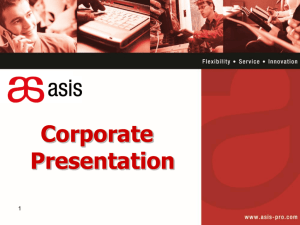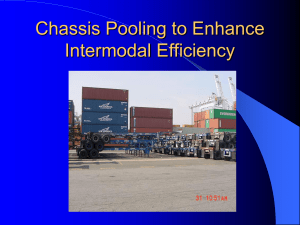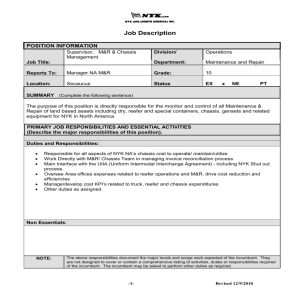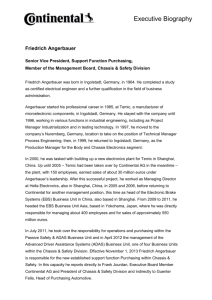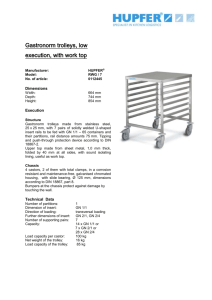Grounded and chassis container terminal operations Introduction
advertisement
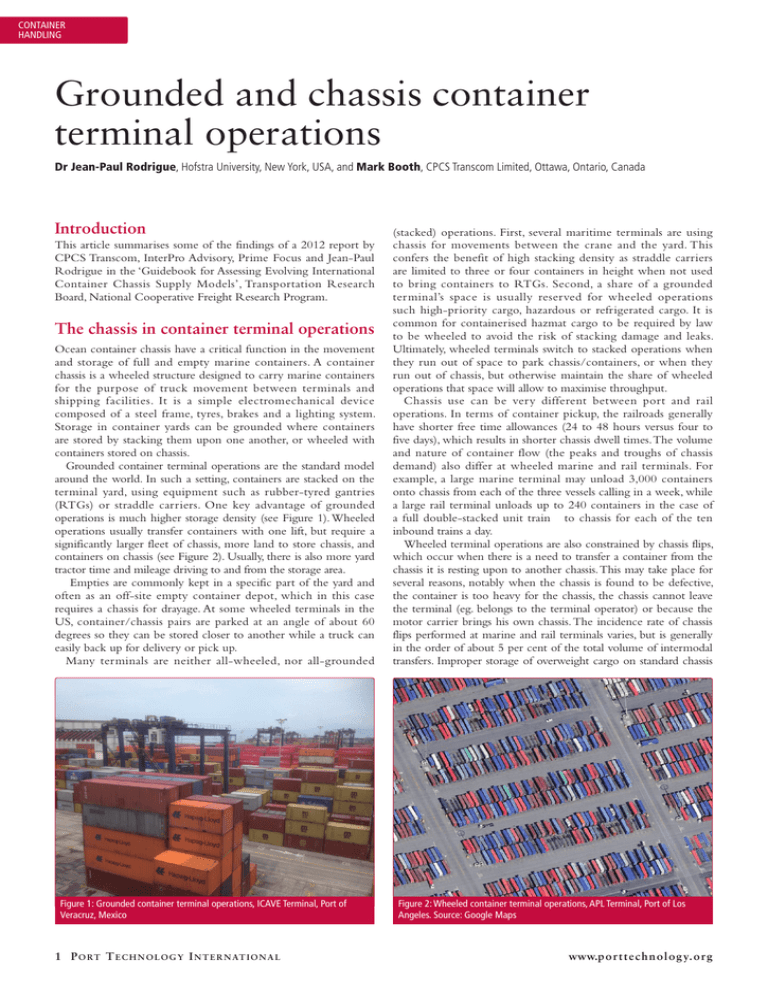
CONTAINER HANDLING Grounded and chassis container terminal operations Dr Jean-Paul Rodrigue, Hofstra University, New York, USA, and Mark Booth, CPCS Transcom Limited, Ottawa, Ontario, Canada Introduction This article summarises some of the findings of a 2012 report by CPCS Transcom, InterPro Advisory, Prime Focus and Jean-Paul Rodrigue in the ‘Guidebook for Assessing Evolving International Container Chassis Supply Models’, Transportation Research Board, National Cooperative Freight Research Program. The chassis in container terminal operations Ocean container chassis have a critical function in the movement and storage of full and empty marine containers. A container chassis is a wheeled structure designed to carry marine containers for the purpose of truck movement between terminals and shipping facilities. It is a simple electromechanical device composed of a steel frame, tyres, brakes and a lighting system. Storage in container yards can be grounded where containers are stored by stacking them upon one another, or wheeled with containers stored on chassis. Grounded container terminal operations are the standard model around the world. In such a setting, containers are stacked on the terminal yard, using equipment such as rubber-tyred gantries (RTGs) or straddle carriers. One key advantage of grounded operations is much higher storage density (see Figure 1). Wheeled operations usually transfer containers with one lift, but require a significantly larger fleet of chassis, more land to store chassis, and containers on chassis (see Figure 2). Usually, there is also more yard tractor time and mileage driving to and from the storage area. Empties are commonly kept in a specific part of the yard and often as an off-site empty container depot, which in this case requires a chassis for drayage. At some wheeled terminals in the US, container/chassis pairs are parked at an angle of about 60 degrees so they can be stored closer to another while a truck can easily back up for delivery or pick up. Many terminals are neither all-wheeled, nor all-grounded Figure 1: Grounded container terminal operations, ICAVE Terminal, Port of Veracruz, Mexico 1 P o rt T e c h n o l o g y I n t e r n at i o n a l (stacked) operations. First, several maritime terminals are using chassis for movements between the crane and the yard. This confers the benefit of high stacking density as straddle carriers are limited to three or four containers in height when not used to bring containers to RTGs. Second, a share of a grounded terminal’s space is usually reserved for wheeled operations such high-priority cargo, hazardous or refrigerated cargo. It is common for containerised hazmat cargo to be required by law to be wheeled to avoid the risk of stacking damage and leaks. Ultimately, wheeled terminals switch to stacked operations when they run out of space to park chassis/containers, or when they run out of chassis, but otherwise maintain the share of wheeled operations that space will allow to maximise throughput. Chassis use can be very different between port and rail operations. In terms of container pickup, the railroads generally have shorter free time allowances (24 to 48 hours versus four to five days), which results in shorter chassis dwell times. The volume and nature of container flow (the peaks and troughs of chassis demand) also differ at wheeled marine and rail terminals. For example, a large marine terminal may unload 3,000 containers onto chassis from each of the three vessels calling in a week, while a large rail terminal unloads up to 240 containers in the case of a full double-stacked unit train to chassis for each of the ten inbound trains a day. Wheeled terminal operations are also constrained by chassis flips, which occur when there is a need to transfer a container from the chassis it is resting upon to another chassis. This may take place for several reasons, notably when the chassis is found to be defective, the container is too heavy for the chassis, the chassis cannot leave the terminal (eg. belongs to the terminal operator) or because the motor carrier brings his own chassis. The incidence rate of chassis flips performed at marine and rail terminals varies, but is generally in the order of about 5 per cent of the total volume of intermodal transfers. Improper storage of overweight cargo on standard chassis Figure 2: Wheeled container terminal operations, APL Terminal, Port of Los Angeles. Source: Google Maps www.porttechnology.org CONTAINER HANDLING ■ Marine Chassis Move ■ Domestic Chassis Move Regional Market / Warehouse or Distribution Center Overseas Markets Distant Hinterland Market / Warehouse or Distribution Center Truck Dray Truck Move Ocean Carrier Move Marine Container Terminal Truck Dray Truck Dray Rail Move Truck Dray Regional Transload Facility Truck Dray Regional Rail Terminal Rail Move Distant Hinterland Intermodal Rail Terminal Figure 3: Chassis use in containerised freight or storage of boxes on defective chassis may be a problem relegated to wheeled operations but are not unavoidable with better yard management systems. Chassis fleets There is no centralised source of data on global or regional chassis fleets. The total US chassis supply is estimated to be around 725,000 units, of which 565,000 are ocean container chassis and 160,000 are domestic container chassis. It is roughly five times that of China, and likely more than twice the combined supply of East Asia, this despite the latter’s container throughput being significantly larger than that in the US. A possible explanatory factor behind the lower supply of chassis in Asia concerns drayage distances and the nature of economic activities. The export-oriented economic development model has favoured the location of factories close to marine terminal facilities. Drayage distances are relatively short and containers are loaded/unloaded immediately, with the tractor remaining hooked to the chassis and the driver waiting until ready for a next move. In this context, the utilisation level of chassis assets is therefore higher. In Europe and Asia chassis are supplied primarily by motor carriers, logistics companies/3PLs, and to a lesser extent leasing companies through long-term leases to trucking operators. In these markets, motor carriers operate the truck and chassis as a single, unattached asset. This arrangement is taking hold in some markets in the US, but remains marginal. In some jurisdictions, including Europe, terminals also own their own chassis fleet; these chassis are used for internal terminal operations only (shunters) and are not roadworthy. Chassis and the hinterland With respect to the movement of containerised imports and exports, Figure 3 highlights the transportation moves in which the chassis is involved (red arrows). A chassis is involved every time an ocean container moves by truck, irrespective of the type of move. Likewise, a domestic chassis is involved every time a 53' domestic container moves to and from a terminal. The use of a transloading facility where the contents of three maritime containers can be transloaded into two domestic containers results in the shift from a maritime to a domestic chassis. The term ‘carrier haulage’ is used when the drayage of a container, and by extension a chassis, is arranged by and under the control of the ocean carrier. The term ‘merchant haulage,’ in contrast, is used when the cargo owner arranges the drayage move with its preferred motor carrier, which must source, in one way or another, a chassis for the related move. In Europe, the majority of ocean containers are carried gate to gate (merchant haulage) and either gate to ocean terminal gate for local (truck) delivery or inland rail terminal gate in the case of railed containers. In parts of Asia including China, Hong Kong and Japan, on the other hand, carrier haulage can be much more common, between 70 per cent and 75 per cent, although in other Asian countries, including Vietnam and Thailand, merchant haulage is more typical. The unique American chassis model The unique American chassis model evolved from shipping lines looking to differentiate themselves in the early days of containerisation. Lines would supply chassis for a complete carrier haulage service. The service intertwined them into the supply chains of their customers, because in addition to the chassis' role in drayage operations, the chassis also provide a storage function, which is largely unique to the US. This takes place in two ways. Firstly, at a terminal site, containers are stored on a chassis until ready for pickup. Wheeled facilities are most typical of rail terminal operations. Also, the shipper's facility containers and the chassis on which they rest are often unhooked from the tractor and left at the shipper's facility for unloading and picked up later (drop and hook operation). In some instances, the container and chassis can be left at a shipper’s facility P o rt T e c h n o l o g y I n t e r n at i o n a l 2 CONTAINER HANDLING for a prolonged period of time (dwell time), thereby representing additional storage space at that shipper's facility, and providing the shipper the option to have different drayage operators dropping and returning cargo, as the motor carrier does not own the chassis. One salient factor is the greater prevalence of wheeled operations at rail terminals than at marine terminals. On the whole, rail terminals make up the majority of wheeled operations, with marine terminals increasingly grounded partially, if not totally, making grounded the more predominant model on the whole. Most rail terminals have to handle both TOFC (trailer on flat car) and COFC (container on flat car) services. Wheeled terminals are a legacy of handling trailers, which accounted for over 70 per cent of the market as recently as the early 1980s. An important shift in the composition of the North American intermodal rail fleet took place in the late 1980s and early 1990s. The development of long distance corridors linking major port gateways such as Los Angeles/Long Beach to inland destinations incited the setting of double-stacked unit train services and a shift toward double-stacked COFC. The TOFC services that used to dominate became marginal. The main reason relates to a more efficient usage of rail assets permitted by double-stacked services as well as the commitment of trucking companies to integrate their drayage services with long distance intermodal rail services. What used to be carried as TOFC (without the use of a container chassis) is now carried as COFC (with a drayage segment) for the first/last mile, using a chassis. Moreover, wheeled terminals were possible on port lands decades ago, but the expedience of priority wheeled service is now at odds with the desires for increased density and grounding. Because of the still low density of the US relative to Europe inland terminals still allow large plots for wheeled chassis storage and a reduced imperative for grounded operations at inland rail facilities. conversion to owning chassis fleets, as well as the maintenance implications of removing chassis inspection and maintenance from the jurisdiction of port labour. On the medium term, a convergence towards the global standard of motor carrier provided chassis is likely to take place, though in the US the misalignment of interests across all parties in the supply chain from ocean carrier to customer are not yet remedied in any fashion. Eventually, grounded terminal operations will emerge as the dominant paradigm with wheeled operations serving niche functions such as high priority cargo, reefers and hazmat. ABOUT THE AUTHORS Dr Jean-Paul Rodrigue is a professor at Hofstra University, New York. His research interests mainly cover the fields of economic and transport geography as they relate to global freight distribution. Area interests involve North America and East and Southeast Asia, particularly China. Specific topics on which he has published extensively cover maritime transport systems and logistics, global supply chains and production networks, gateways and transport corridors, international trade and regional development. Mark Booth is a senior consultant at CPCS, a management consulting firm focused on transportation strategy based in Ottawa. He has completed a diverse array of engagements dealing with multimodal freight transportation in Canada and the US, including multiple engagements for the Transportation Research Board. Internationally, his work has consisted of financial modelling support for transaction advisory and feasibility studies. ABOUT THE COMPANY PortEconomics is a web-based initiative aiming at generating and disseminating knowledge about The future of the container chassis Around the world, the chassis remains a crucial component of intermodal transport chains. Their role in terminal operations is in decline, notably in North American rail terminals that are switching to grounded operations, particularly at new facilities, though not as quickly as some proponents would hope to see, with extensive wheeled facilities such as UP’s Joliet terminal still being commissioned in recent years. The setting of inland terminals is also switching chassis drayage operations further inland which usually involves shorter distances and thus less chassis; that same chassis gets a higher utilisation level. Additionally, maritime shipping companies which have conventionally provided chassis in many American port terminals are pulling out of the chassis business, which is switching to various types of chassis pooling arrangements, as motor carriers as an entire industry are not capable to perform a wholesale 3 P o rt T e c h n o l o g y I n t e r n at i o n a l seaports (www.porteconomics.eu ). It is developed and empowered by the members of the PortEconomics group, who are actively involved in academic and contract research in port economics, management, and policy. Since October 2012, Port Technology International and PortEconomics are engaged in a partnership. ENQUIRIES Dr. Jean-Paul Rodrigue Dept. of Global Studies & Geography - Hofstra University Hempstead, New York (United States) Email: jean-paul.rodrigue@hofstra.edu Mark Booth, MBA Senior Consultant, CPCS Ottawa, ON (Canada) Email: mbooth@cpcstrans.com www.porttechnology.org

